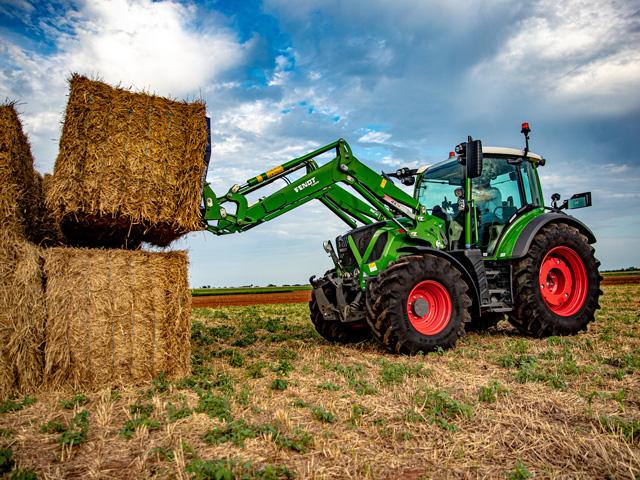MachineryLink
Tractor, Combine Sales Up Double Digits in 2021, as Small-Tractor Sales Lose Steam
Nearly 360,000 total tractors and combines left dealer lots in 2021 in North America. U.S. and Canadian unit sales of ag tractors and combines finished 2021 with gains of more than 10% in nearly every segment in both countries, according to the latest data from the Association of Equipment Manufacturers (AEM).
Breaking that number down between tractors and combines, U.S. and Canadian sales in 2021 totaled 317,897 tractors, and 6,272 combine harvesters found new homes in the U.S. in 2021.
U.S. total farm tractor sales gained 0.3% for December compared to 2020, while U.S. self-propelled combine sales for the month saw a gain of 25.3%.
Those gains contributed to a total gain for the year of 10.3% for tractors and 24.7% for combine harvesters. For the year, the only segment in either the U.S. or Canada that gained less than 10% was under-40-horsepower tractors in the U.S., growing 8.9%.
The overall growth leader for tractors in the U.S. were 100-plus-horsepower two-wheel-drive (2WD) tractors, growing 24.1%, followed by articulated four-wheel-drive (4WD) tractors, up 18.3%.
In Canada, sales of tractors for December grew 10.5%, while combines fell 17.6% year over year. Total sales for 2021 were up 19.4% for tractors and up 23.1% for combines.
The slowest-selling segment in Canada, the 40- to 100-hp 2WD range of tractors, still grew an impressive 14.4% for the year. The leading tractor segment, 100-plus-hp 2WD units grew 33.6%, followed closely by articulated 4WD units up 32.7%.
A total of 33,463 tractors and 1,786 combine harvesters were sold in Canada in 2021.
Last year was a major part of what has become a success story in the times that COVID-19 has brought to farms and machinery equipment manufacturers.
COVID-19 did hit the ag industry hard, at first. In March 2020, sales of all tractors and combines tanked.
P[L1] D[0x0] M[300x250] OOP[F] ADUNIT[] T[]
"Sales hit a cliff, and we absolutely just stopped," said Curt Blades, senior vice president, industry sectors and product leadership at the Association of Equipment Manufacturers (AEM). "There was a week period, you can look at the sales numbers (and) it was bleak. I think there was a panic in the marketplace. And dealers were shutting down."
But that sharp downturn didn't last long. By the next month, April 2020, signs of life began to reappear, especially in under-40-hp tractor sales. Year-over-year sales numbers were rising 10%, even 20% in the small-tractor categories. By November 2020, sales of over-100-hp tractors began to show better sales activity.
"You could see signs that the farm economy (considered one of the nation's essential industries) was looking pretty positive," Blades said. "So, we're reporting these numbers for 2021, tractor sales up 10% and combines up 25%."
Sales of tractors under 100 hp did began to cool in the second half of 2021. One reason may be that so many tractors were sold in that horsepower range, that small-tractor market is satisfied, albeit temporarily. Blades said the small-tractor market has been growing for 20 years, and he doesn't expect that to end.
Supply disruptions still affect the farm equipment manufacturing. Parts, electronics, tires, steel, aluminum, transportation and labor shortages all contribute.
"Our supply chain problems are real; I'm not going to diminish them at all, they're very real," Blades said. "But other markets have fared much worse. There have been very few major shutdowns of (farm equipment) factories. It hasn't been like auto manufacturing, where they were shut down for months at a time."
What about 2022?
Blades is fairly optimistic about continuing strength in tractor and combine sales. "The farm economy is showing really nice signs of life and growth. However, I do have some concerns about the annual cost of inputs," he said. "Farmers are paying the fertilizer bills right now, and they may have some questions about what the market is going to look like."
Blades believes farmers are -- or should be -- strategic about their equipment purchases. "Making a plan for equipment is not a bad thing at all," he said. "A half-million-dollar combine shouldn't be an impulse purchase. You should know today whether you need a combine tomorrow or five years from now. We encourage all farmers to work closely with the dealers to kind of build an equipment plan."
DTN/PF took the opportunity of time with Blades to ask him about one more area -- autonomy. John Deere introduced its autonomous 8R tractor at the CES in Las Vegas two weeks ago. There are other autonomous tractors from other manufacturers already operating in orchards and vineyards on the West Coast and in Midwestern row-crop fields.
What does Blades think about the new era of autonomous farm equipment?
"The industry has got a lot of really cool things going on, on the autonomous front," Blades said. "Autonomous equipment makes sense. You think of how much auto steer has changed a farmer's operation. You can take those same benefits and take them to next level when you begin to eliminate things like staffing concerns."
But will autonomy produce a return on investment? Blades thinks so.
He recalled an advertisement that had a tagline, "Cool Costs Money."
Autonomy is cool, he said. "But this also potentially saves money. And that's what's exciting about autonomy in the ag industry. It actually makes farmers money or saves farmers money."
The full tractor and combine reports from AEM can be found in the Market Data section of the AEM website under Ag Tractor and Combine Reports.
U.S.: https://www.aem.org/…
Canada: https://www.aem.org/…
Dan Miller can be reached at dan.miller@dtn.com
Follow him on Twitter @DMillerPF
(c) Copyright 2022 DTN, LLC. All rights reserved.




